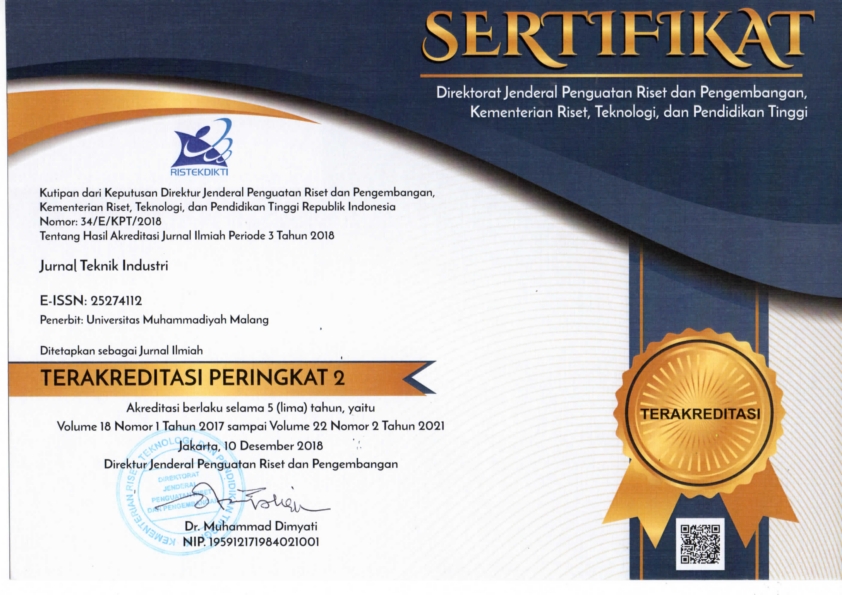Perancangan Ulang Produk Paving Stone untuk Peningkatan Kualitas dengan Pendekatan Metode Taguchi dan Rekayasa Nilai
DOI:
https://doi.org/10.22219/JTIUMM.Vol9.No2.155-163Keywords:
taguchi, value engineering, ortogonal arrayAbstract
Production goods, in this case paving stone is result from a production process have characteristic depicting performance. Producer as producer of product try the to product performance can fulfill expectation and desire of consumer. To improve the quality of paving stone, operator perform examination by setting change to factors having an effect on according to empirically and manual book. Factors having an effect on the among others : cement portland, water, sand, and also stone ash. Intention of this research is to specify maximum setting of factors in control having an effect on by isn’t it to value of variability strong depress paving stone, was so that got by strong measure depress the smallerness and or come near 200 kg/cm2. This research was done at process of paving stone. Experiment device the used is experiment device with method of Taguchi with model of matrix orthogonal array of L27 (313). And then done by confirmation experiment is stipulating of optimal setting of experiment of Taguchi. Analysis Data done pursuant to optimise of combination of level strong mean factor depress and paving of Signal Noise Ratio to ( Ratio of S/N). Analysis result indicated that cement of portland, water, sand, and stone ash having an effect on by isn’t it to strength depress paving stone. Maximum Setting reached at combination cement level 1 (0.37 kg); irrigate level 1 (0.2 lt); sand (1.9 kg) and stone ash of level 1 (0.8 kg). By using maximum setting, confirmation experiment result yield strength depress maximum paving, that is 189.3 kg/cm2. Value yielded at composition is 1.283.
Downloads
References
Belavendram, N., 1995. Quality by Design: Taguchi Techniques for Industrial Experimentation. New York: Prentice Hall.
Frick, Heinz dan Koesmartadi, Ch., 1999. Ilmu Bahan Bangunan: Eksploitasi, Pembuatan, Penggunaan dan Pembuangan. Yogyakarta: Penerbit Kanisius.
Frick, H., 1980. Ilmu Konstruksi Bangunan I. Yogyakarta: Penerbit Kanisius.
Retno, P.D., 2003. Diktat Rekayasa Nilai, Universitas Muhammadiyah Malang.
Ross, P.J., 1988. Taguchi Techniques for Quality Engineering, McGraw-Hill, 1st ed. New York.
Soejanto, I., 2002. Rancangan Eksperimen. Surabaya: Penerbit Yayasan Humaniora.
Sudjana, 2004. Desain dan Analisis Eksperimen. Bandung: Penerbit Tarsito.
Sudjana, 1996. Metoda Statistika. Penerbit Tarsito, Edisi ke-6. Bandung.
Utojo, R., dan Harun N., 1953. Bangunan dalam Beton Tekan. Jakarta: Penerbit Buku Teknik H. STAM.
Utojo, R., dan Harun N., 1982. Persyaratan Umum Bahan Bangunan di Indonesia. Direktorat Penyelidikan Masalah Bangunan, Bandung. 1982.
Utojo, R., dan Harun N., Manual Pemeriksaan Bahan Jalan. Direktorat Jenderal Bina Marga.











